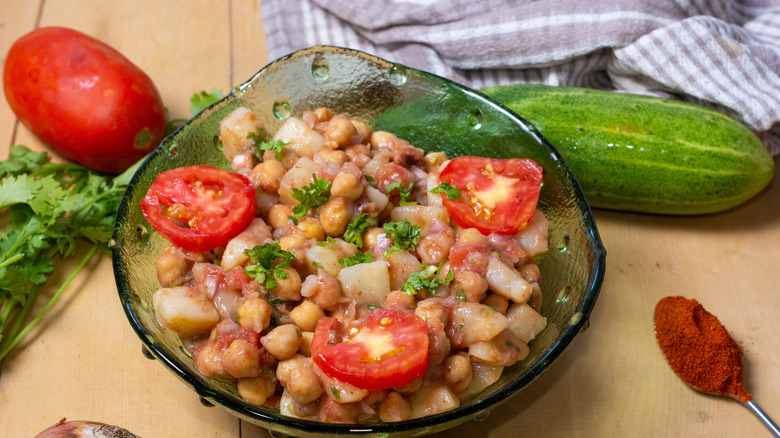This Simple Trick Makes Canned Chickpeas Softer And More Flavorful
When it comes to canned foods, there's not a lot of downsides to choosing chickpeas. They're versatile, shelf-stable, and the canned versions come pre-cooked and ready to toss into a salad or wrap (though you may want to rinse them first). A well-known source of plant-based protein, chickpeas are also jam-packed with a ton of other vitamins, including fiber, magnesium, potassium, folate, and much more. This means that your favorite chorizo chickpea salad with feta is not only rich in flavor, it's also a nutritional powerhouse. Yet, if you're not a fan of the texture, there's something you can do — pressure cook them first.
Most chickpeas are canned with calcium chloride — a preservative added to prevent them from swelling and bursting inside the can. An unfortunate side effect of this preservation method is that it makes chickpeas chewy and tough, which isn't ideal if you're making a luscious stew or blending them into a creamy hummus. Some people use a pinch of baking soda when cooking canned chickpeas. Just a tiny pinch of baking soda counteracts this effect, resulting in a soft, velvety texture perfect for mashing into vegan "chicken" salad or folding into a curry.
If you're out of baking soda or especially pressed for time, don't worry — your pressure cooker can also easily get the job done. This method may take a little bit longer (about 30 minutes in total), but the results are nearly perfect every time. Plus, pressure cooking offers an opportunity to infuse your chickpeas with a wide array of savory and spicy flavors.
Do's and don'ts of pressure-cooking canned chickpeas
The key to softening your canned chickpeas in the pressure cooker is timing. The total cook time inside the pressure cooker is only about 5 minutes, but you also have to account for the time it takes for the appliance to build and release pressure before and after cooking, respectively. Additionally, there are no shortcuts when it comes to using a pressure cooker — if it fails to build pressure properly, your food could be undercooked, while opening it before the pressure fully releases is very dangerous.
Both building and releasing pressure properly takes roughly 10 minutes, so you'll need to add about a half-hour to your expected cooking time when using this method. However, if you're going to add extra time to your meal prep, you might as well take advantage of it by infusing your chickpeas with deep flavor. Instead of using the aquafaba (bean liquid) from the can, rinse your beans and use stock. You can also add aromatics like whole spices, woody herbs, or citrus slices to your 'peas, allowing the pressure to push the flavors into them.
Other than the expected safety precautions, one big no-no when it comes to softening canned chickpeas is to avoid doubling up on methods. Adding baking soda to chickpeas in the pressure cooker will increase the softening power of both, and give you mushy, unappetizing results. Instead, choose the method that suits your needs to give your dish the most desirable texture.

